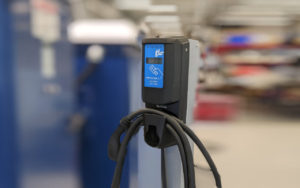Private light- and medium-duty fleet vehicles could benefit from charging network operator FLO’s claimed speeds of up to 70 per cent of a 25kW DC fast charger at 30 per cent of the cost

Private light- and medium-duty fleet vehicles could benefit from charging network operator FLO’s claimed speeds of up to 70 per cent of a 25kW DC fast charger at 30 per cent of the cost
As battery technology and the variety of vehicles being electrified increases, so too do the charging demands and expectation of drivers and fleet managers.
Charging network operator FLO today unveiled a new product that it says will help fill one emerging niche — a low-cost, higher-speed Level 2 charger for private light- and medium-duty fleet vehicles such as pick-up trucks and small service trucks.
“”As battery sizes increase at a faster pace, we believe that future-proofing your sizeable investment in EV infrastructure is key,” says Jeff Dion, FLO’s director of product line management, speaking at the Electric Mobility Canada 2020 conference.
Power and flexibility
Its new solution is the CoRE+Max charger. Unlike most Level 2 chargers which have a maximum power output of 30 amps, this unit has an 80 amp capacity at 19kW. It’s also flexible, with nine charge settings ranging from 24 to 80 amps. FLO says that at the top end it offers 70 per cent of the speed of a 25kW DC fast charger at 30 per cent of the cost.
“For the same cost as installing one 25kW DC fast charger, you can install four or more CoRe+Max’s,” says Dion.
That versatility, FLO hopes, will help to push electrification adoption into last-mile delivery vehicles, mid-sized passenger vehicles and school bus transit.
Other advantages over the DC fast charger include “lower installation costs, power management solutions and causing less strain on the vehicle’s battery,” says Dion.
The flexible charge settings, meanwhile, are aimed at users who don’t need the full power currently. But when they do, he says, they’ll have it without having to upgrade to new hardware.
Adapting to an evolving market
FLO says its product roadmap is based on projections of a rapidly evolving market.
By 2030, for example, it expects that EVs will account for 10 per cent of all vehicles and battery range will increase to 750 kilometres. It foresees price parity with internal combustion vehicles much sooner, by 2024-2025. This market growth will also include waves of new commercial vehicles.
Consequently, says Dion, any chargers they make today must also meet the needs of tomorrow and, ideally, the days after that.
Other conference participants echoed this focus on fleets and commercial vehicles. Growth in this area — and its implications for infrastructure, impact on utilities and the grid, related trends in battery technology and priorities in public policy — has been a major theme on panels and company breakouts.






